Miniaturized Coplanar Waveguide-Fed UWB Antenna for Wireless Applications
Abstract
1. Introduction
2. Literature Survey
3. Antenna Design
4. Simulation Consequences and Discussion
5. Fabrication and Measurements
6. Rectifier Antenna (Rectenna)
Simulated and Measured Results of Antenna and Rectifier Circuit
7. Conclusions
Author Contributions
Funding
Data Availability Statement
Acknowledgments
Conflicts of Interest
References
- Varum, T.; Caiado, J.; Matos, J. Compact Ultra-Wideband Series-Feed Microstrip Antenna Arrays for IoT Communications. Appl. Sci. 2021, 11, 6267. [Google Scholar] [CrossRef]
- Sediq, H.T.; Nourinia, J.; Ghobadi, C.; Mohammadi, B. A novel shaped ultrawideband fractal antenna for medical purposes. Biomed. Signal Process. Control. 2023, 80, 104363. [Google Scholar] [CrossRef]
- Abbas, A.; Hussain, N.; Jeong, M.-J.; Park, J.; Shin, K.S.; Kim, T.; Kim, N. A Rectangular Notch-Band UWB Antenna with Controllable Notched Bandwidth and Centre Frequency. Sensors 2020, 20, 777. [Google Scholar] [CrossRef] [PubMed]
- Wang, M.; Wang, H.; Chen, P.; Ding, T.; Xiao, J.; Zhang, L. A butterfly-like slot UWB antenna with WLAN band-notch characteristics for MIMO applications. IEICE Electron. Express 2022, 19, 20220233. [Google Scholar] [CrossRef]
- Saha, T.K.; Goodbody, C.; Karacolak, T.; Sekhar, P.K. A compact monopole antenna for ultra-wideband applications. Microw. Opt. Technol. Lett. 2019, 61, 182–186. [Google Scholar] [CrossRef]
- Soni, R.; Gupta, R.; Sen, D. Efficient Design of Micro Strip Patch Antenna for the Ultra-Wideband (UWB) Applications. Int. J. Recent Technol. Eng. (IJRTE) 2020, 8, 4517–4520. [Google Scholar] [CrossRef]
- Dwivedi, A.K.; Mishra, B.; Singh, V.; Tripathi, P.N.; Singh, A.K. Design of a Compact CPW-Fed Monopole Antenna With Asymmetrical Hexagonal Slot Loaded Ground Structure for C/X/Ku Band Applications. Electr. Control. Commun. Eng. 2020, 16, 15–22. [Google Scholar] [CrossRef]
- Venkatachalam, D.; Govindasamy, M. A CPW-Fed hexagonal antenna with fractal elements for UWB applications. Appl. Math. Inf. Sci. Int. J. 2019, 13, 73–79. [Google Scholar]
- Pandey, A.K.; Singh, R. CPW Fed Micro Strip Patch Antenna for Wireless Communication. Int. J. Eng. Adv. Technol. 2017, 6, 196–200. [Google Scholar]
- Awan, W.A.; Zaidi, A.; Hussain, N.; Iqbal, A.; Baghdad, A. Stub loaded, low profile UWB antenna with independently controllable notch-bands. Microw. Opt. Technol. Lett. 2019, 61, 2447–2454. [Google Scholar] [CrossRef]
- Al-Azzawi, A.A.; Al-Hilalli, A.; Al-Majdi, K.; Almukhtar, A.A.; Mezaal, Y.S. New miniature microstrip antenna for UWB wireless communications. Proc. Est. Acad. Sci. 2022, 71, 194. [Google Scholar] [CrossRef]
- Al-Gburi, A.J.A.; Ibrahim, I.; Zeain, M.Y.; Zakaria, Z. Compact Size and High Gain of CPW-fed UWB Strawberry Artistic shaped Printed Monopole Antennas using FSS Single Layer Reflector. IEEE Access 2020, 8, 92697–92707. [Google Scholar] [CrossRef]
- Aissaoui, D.; Chaabane, A.; Boualleg, A.; Guerroui, M. Coplanar Waveguide-fed UWB Slotted Antenna with Notched-band Performance. Period. Polytech. Electr. Eng. Comput. Sci. 2021, 65, 69–73. [Google Scholar] [CrossRef]
- Rahman, M.; NagshvarianJahromi, M.; Mirjavadi, S.S.; Hamouda, A.M. Compact UWB Band-Notched Antenna with Integrated Bluetooth for Personal Wireless Communication and UWB Applications. Electronics 2019, 8, 158. [Google Scholar] [CrossRef]
- Ahmad, S.; Ijaz, U.; Naseer, S.; Ghaffar, A.; Qasim, M.A.; Abrar, F.; Parchin, N.O.; See, C.H.; Abd-Alhameed, R. A Jug-Shaped CPW-Fed Ultra-Wideband Printed Monopole Antenna for Wireless Communications Networks. Appl. Sci. 2022, 12, 821. [Google Scholar] [CrossRef]
- Al-Gburi, A.J.A.; Ibrahim, I.M.; Zakaria, Z.; Abdulhameed, M.K.; Saeidi, T. Enhancing Gain for UWB Antennas Using FSS: A Systematic Review. Mathematics 2021, 9, 3301. [Google Scholar] [CrossRef]
- Yeboah-Akowuah, B.; Tchao, E.T.; Ur-Rehman, M.; Khan, M.M.; Ahmad, S. Study of a printed split-ring monopole for dual-spectrum communications. Heliyon 2021, 7, e07928. [Google Scholar] [CrossRef]
- Al-Gburi, A.J.A.; Ibrahim, I.B.M.; Zakaria, Z.; Ahmad, B.H.; Bin Shairi, N.A.; Zeain, M.Y. High Gain of UWB Planar Antenna Utilising FSS Reflector for UWB Applications. Comput. Mater. Contin. 2022, 70, 1419–1436. [Google Scholar] [CrossRef]
- Benkhadda, O.; Ahmad, S.; Saih, M.; Chaji, K.; Reha, A.; Ghaffar, A.; Khan, S.; Alibakhshikenari, M.; Limiti, E. Compact Broadband Antenna with Vicsek Fractal Slots for WLAN and WiMAX Applications. Appl. Sci. 2022, 12, 1142. [Google Scholar] [CrossRef]
- Anveshkumar, N.; Gandhi, A.S. A survey on microstrip antennas for portable wireless communication system applications. In Proceedings of the 2017 International Conference on Advances in Computing, Communications and Informatics (ICACCI), Udupi, India, 13–16 September 2017; pp. 2156–2165. [Google Scholar]
- Seker, C.; Güneşer, M.T. A single band antenna design for future millimeter wave wireless communication at 38 GHz. Eur. J. Eng. Form. Sci. 2018, 2, 34–38. [Google Scholar]
- Khanna, P.; Sharma, A.; Singh, A.K.; Kumar, A. A novel approach for production challenges of flexible microstrip patch antenna. Brill. Eng. 2019, 1, 7–12. [Google Scholar]
- Mondal, K. Bandwidth and gain enhancement of microstrip antenna by frequency selective surface for WLAN, WiMAX applications. Sadhana 2019, 44, 233. [Google Scholar] [CrossRef]
- Al-Ahmadi, A.; Khraisat, Y.S.H. Bandwidth Enhancement of Microstrip Patch Antenna. Appl. Phys. Res. 2019, 11, p35. [Google Scholar] [CrossRef]
- Tao, L.; Xu, J.; Li, H.; Hao, Y.; Huang, S.; Lei, M.; Bi, K. Bandwidth Enhancement of Microstrip Patch Antenna Using Complementary Rhombus Resonator. Wirel. Commun. Mob. Comput. 2018, 2018, 6352181. [Google Scholar] [CrossRef]
- Hamza, Q.M.; Nabil, S.M.; Hassan, M. Novel CPW-fed UWB antenna for X-band applications. Int. Symp. Adv. Electr. Commun. Technol. (ISAECT) 2019, 4, 78–82. [Google Scholar] [CrossRef]
- Sanmugasundaram, R.; Dileepan, D.; Natarajan, S. Design of CPW antenna for network applications. Int. J. Eng. Technol. 2018, 7, 2525–2527. [Google Scholar] [CrossRef]
- Sharma, A.; Khanna, P.; Shinghal, K.; Kumar, A. Design of CPW-Fed Antenna with Defected Substrate for Wideband Applications. J. Electr. Comput. Eng. 2016, 2016, 6546481. [Google Scholar] [CrossRef]
- Khanna, P.; Sharma, A.; Singh, A.K.; Kumar, A. A CPW—Fed octagonal ring-shaped wideband antenna for wireless applications. Adv. Electromagn. 2018, 7, 87–92. [Google Scholar] [CrossRef]
- Quddious, A.; Abbasi, M.A.B.; Antoniades, M.A.; Vryonides, P.; Fusco, V.; Nikolaou, S. Dynamically Reconfigurable UWB Antenna Using an FET Switch Powered by Wireless RF Harvested Energy. IEEE Trans. Antennas Propag. 2020, 68, 5872–5881. [Google Scholar] [CrossRef]
- Jansari, D.V.; Amineh, R.K. A two-element antenna array for compact portable MIMO-UWB communication systems. AIMS Electron. Electr. Eng. 2019, 3, 224–232. [Google Scholar] [CrossRef]
- Simorangkir, R.B.; Kiourti, A.; Esselle, K.P. UWB Wearable Antenna With a Full Ground Plane Based on PDMS-Embedded Conductive Fabric. IEEE Antennas Wirel. Propag. Lett. 2018, 17, 493–496. [Google Scholar] [CrossRef]
- Negi, D.; Khanna, R.; Kaur, J. Design and performance analysis of a conformal CPW fed wideband antenna with Mu-Negative metamaterial for wearable applications. Int. J. Microw. Wirel. Technol. 2019, 11, 806–820. [Google Scholar] [CrossRef]
- Rusdiyanto, D.; Apriono, C.; Astuti, D.W.; Muslim, M. Bandwidth and Gain Enhancement of Microstrip Antenna Using Defected Ground Structure and Horizontal Patch Gap. Sinergi 2021, 25, 153–158. [Google Scholar] [CrossRef]
- Lu, P.; Song, C.; Huang, K.M. Ultra-Wideband Rectenna Using Complementary Resonant Structure for Microwave Power Transmission and Energy Harvesting. IEEE Trans. Microw. Theory Tech. 2021, 69, 3452–3462. [Google Scholar] [CrossRef]
- Kumar, T.R.; Madhavan, M. Design and Optimization of Wearable Microstrip Patch Antenna using Hybrid Fuzzy Flamingo Swarm Optimization Algorithm for RF Energy Harvesting. Iran. J. Sci. Technol. Trans. Electr. Eng. 2022, 5, 1–20. [Google Scholar] [CrossRef]
- Imran, A.I.; Elwi, T.A.; Salim, A.J. On the Distortionless of Uwb Wearable Hilbert-Shaped Metamaterial Antenna for Low Energy Applications. Prog. Electromagn. Res. M 2021, 101, 219–239. [Google Scholar] [CrossRef]
- Kumar, M.; Kumar, S.; Jain, S.; Sharma, A. A Plug-in Type Integrated Rectenna Cell for Scalable RF Battery Using Wireless Energy Harvesting System. IEEE Microw. Wirel. Compon. Lett. 2022, 33, 98–101. [Google Scholar] [CrossRef]
- Shi, Y.; Jing, J.; Fan, Y.; Yang, L.; Wang, M. Design of a Novel Compact and Efficient Rectenna for Wifi Energy Harvesting. Prog. Electromagn. Res. C 2018, 83, 57–70. [Google Scholar] [CrossRef]
- Mathur, M.; Agrawal, A.; Singh, G.; Bhatnagar, S.K. A compact coplanar waveguide fed wideband monopole antenna for RF energy harvesting applications. Prog. Electromagn. Res. M 2018, 63, 175–184. [Google Scholar] [CrossRef]
- Koohestani, M.; Tissier, J.; Latrach, M. A miniaturized printed rectenna for wireless RF energy harvesting around 2.45 GHz. AEU—Int. J. Electron. Commun. 2020, 127, 153478. [Google Scholar] [CrossRef]
- Ismail, N.; Kadir, E.A. Reversed L-type Matching Impedance of RF-to-DC Rectifier for Energy Harvesting System. J. Electr. Electron. Syst. Res. 2021, 19, 167–172. [Google Scholar] [CrossRef]
- Cai, X.; Geyi, W.; Guo, Y. A Compact Rectenna With Flat-Top Angular Coverage for RF Energy Harvesting. IEEE Antennas Wirel. Propag. Lett. 2021, 20, 1307–1311. [Google Scholar] [CrossRef]
- Yadav, K.; Chaturvedi, A.; Sharma, G.K. Comparative Study of Antenna in RF -Energy Harvesting. In Proceedings of the 2022 2nd International Conference on Power Electronics & IoT Applications in Renewable Energy and its Control (PARC), Mathura, India, 21–22 January 2022; pp. 1–7. [Google Scholar] [CrossRef]
- Adami, S.E.; Zhu, D.; Li, Y.; Mellios, E.; Stark, B.H.; Beeby, S. A 2.45 GHz rectenna screen-printed on polycotton for on-body RF power transfer and harvesting. In Proceedings of the 2015 IEEE Wireless Power Transfer Conference (WPTC), Boulder, CO, USA, 13–15 May 2015; pp. 1–4. [Google Scholar]
- Valenta, C.R.; Durgin, G.D. Harvesting Wireless Power. IEEE Microw. Mag. 2014, 15, 108–120. [Google Scholar]
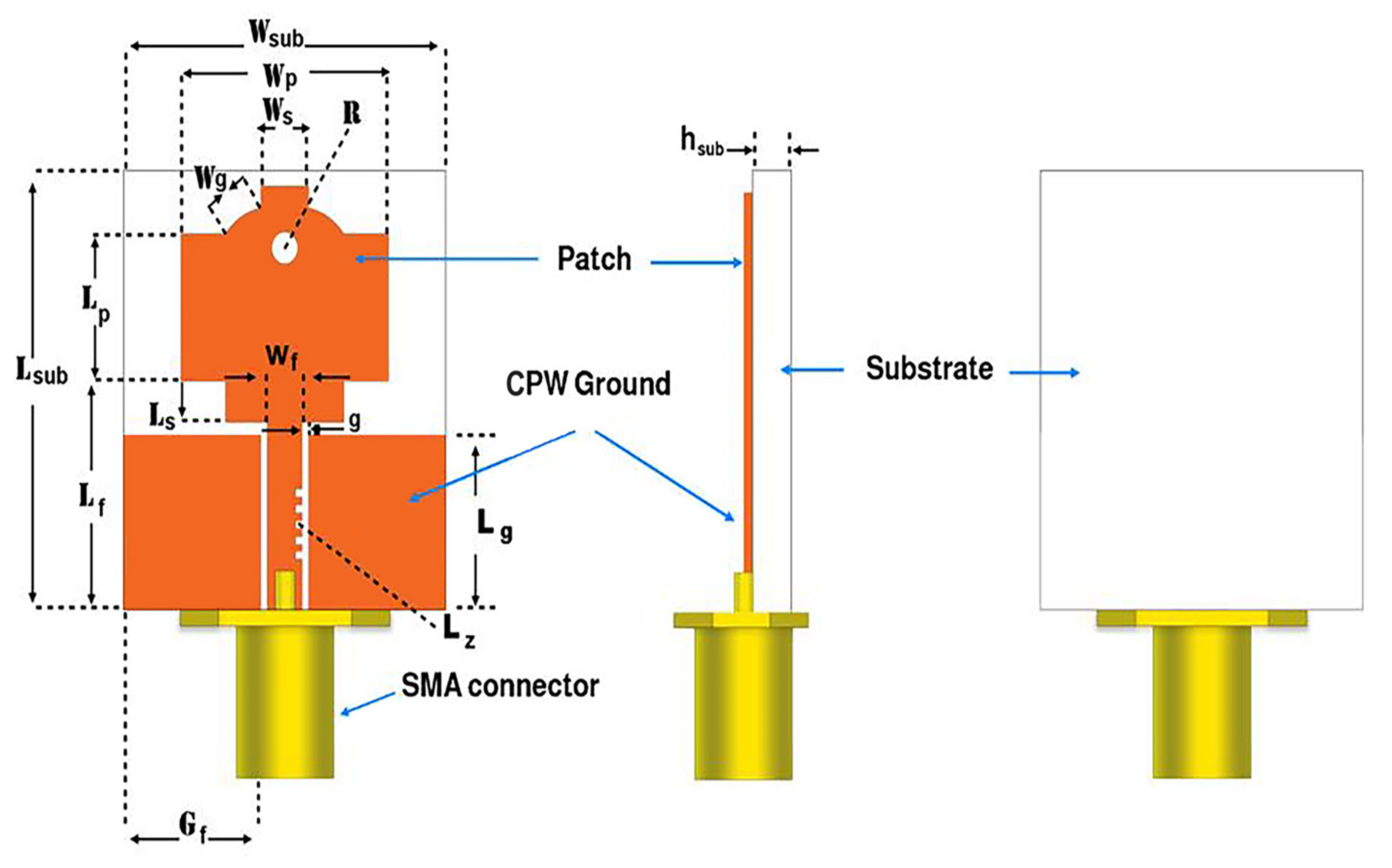
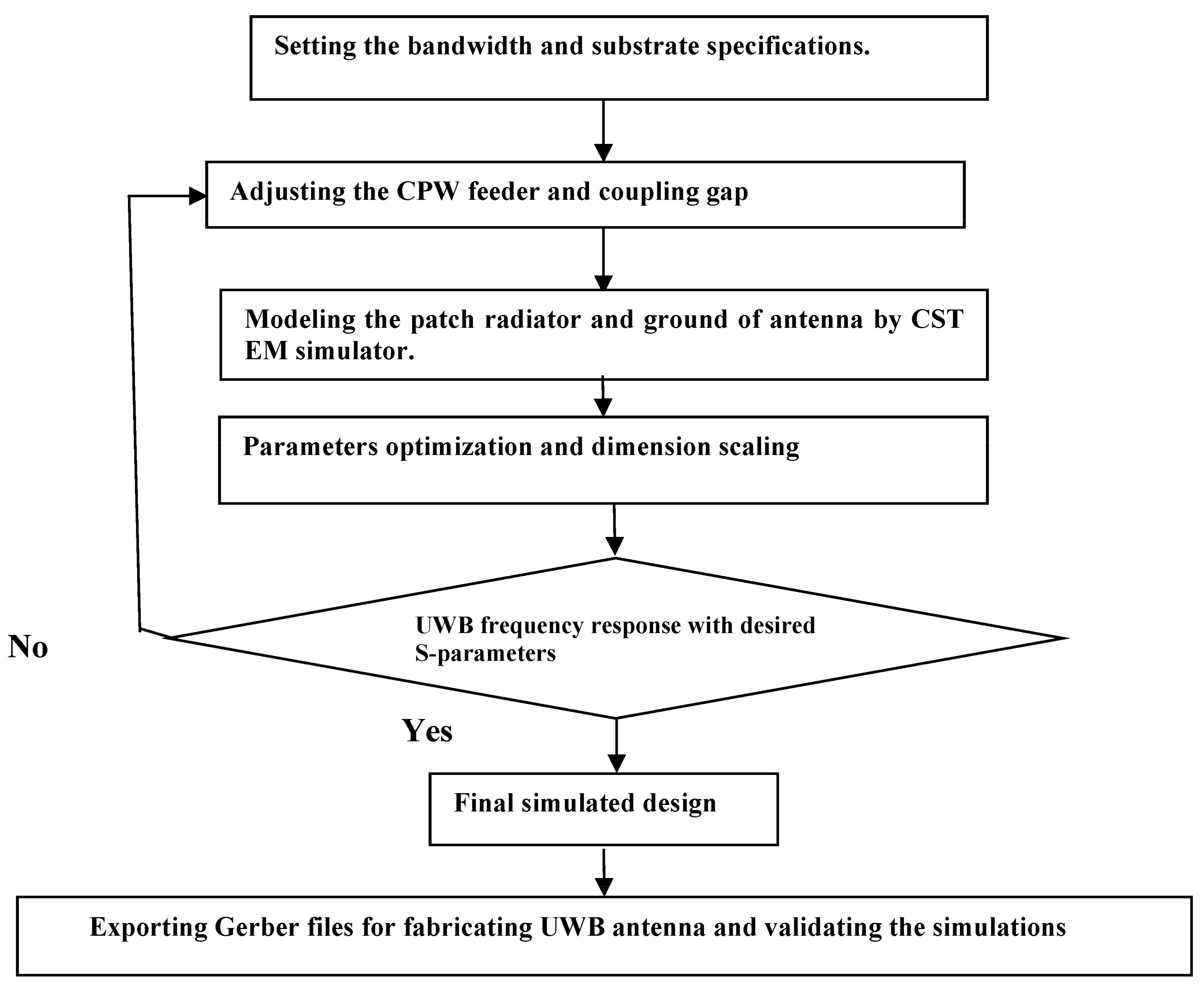
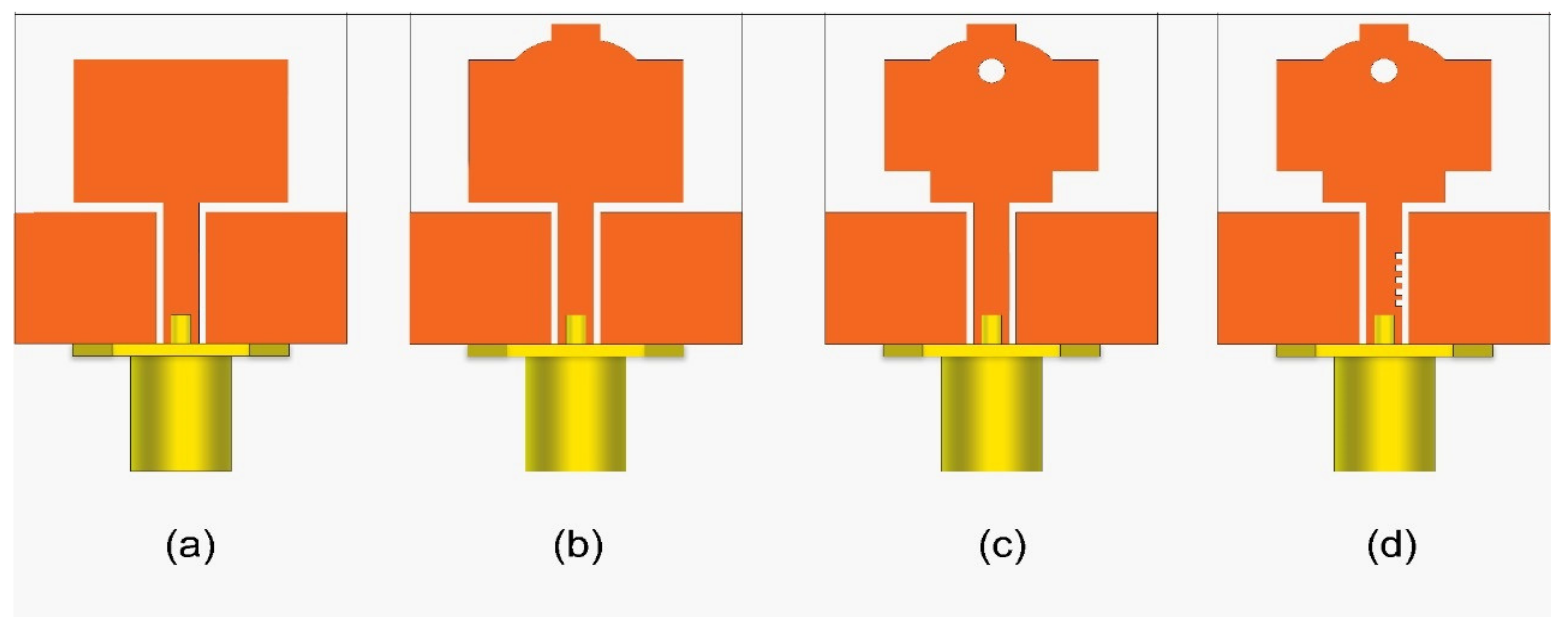
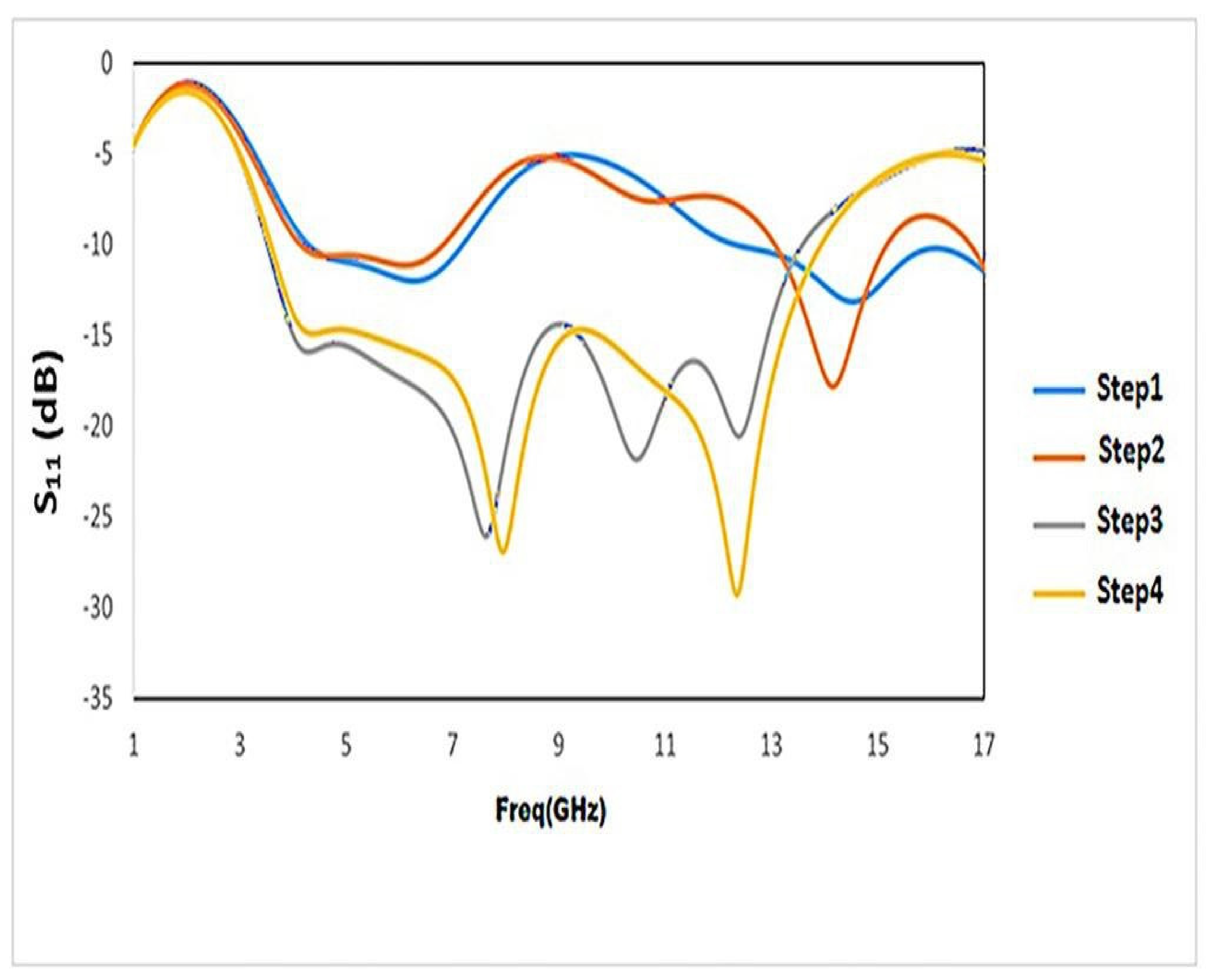
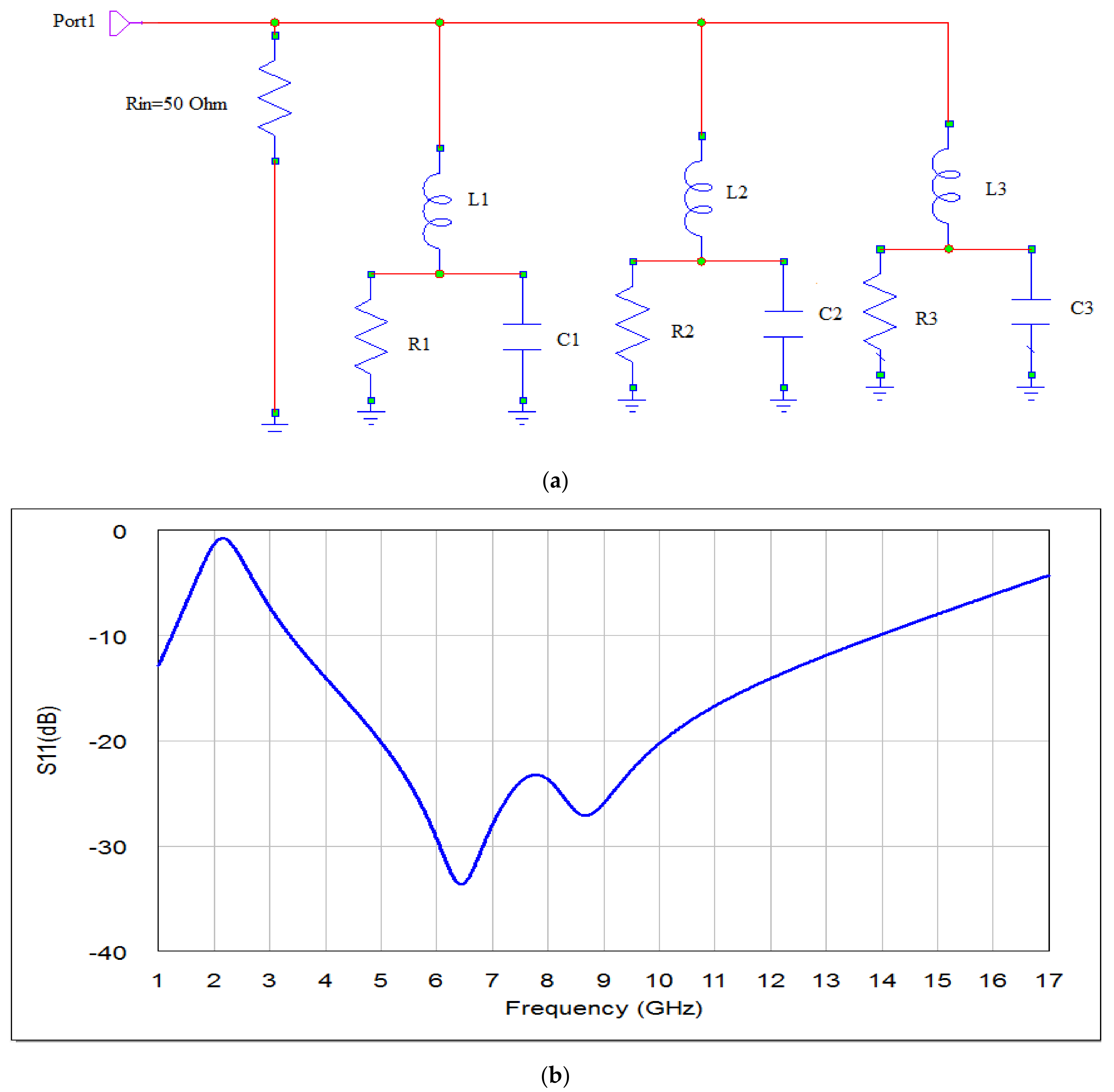
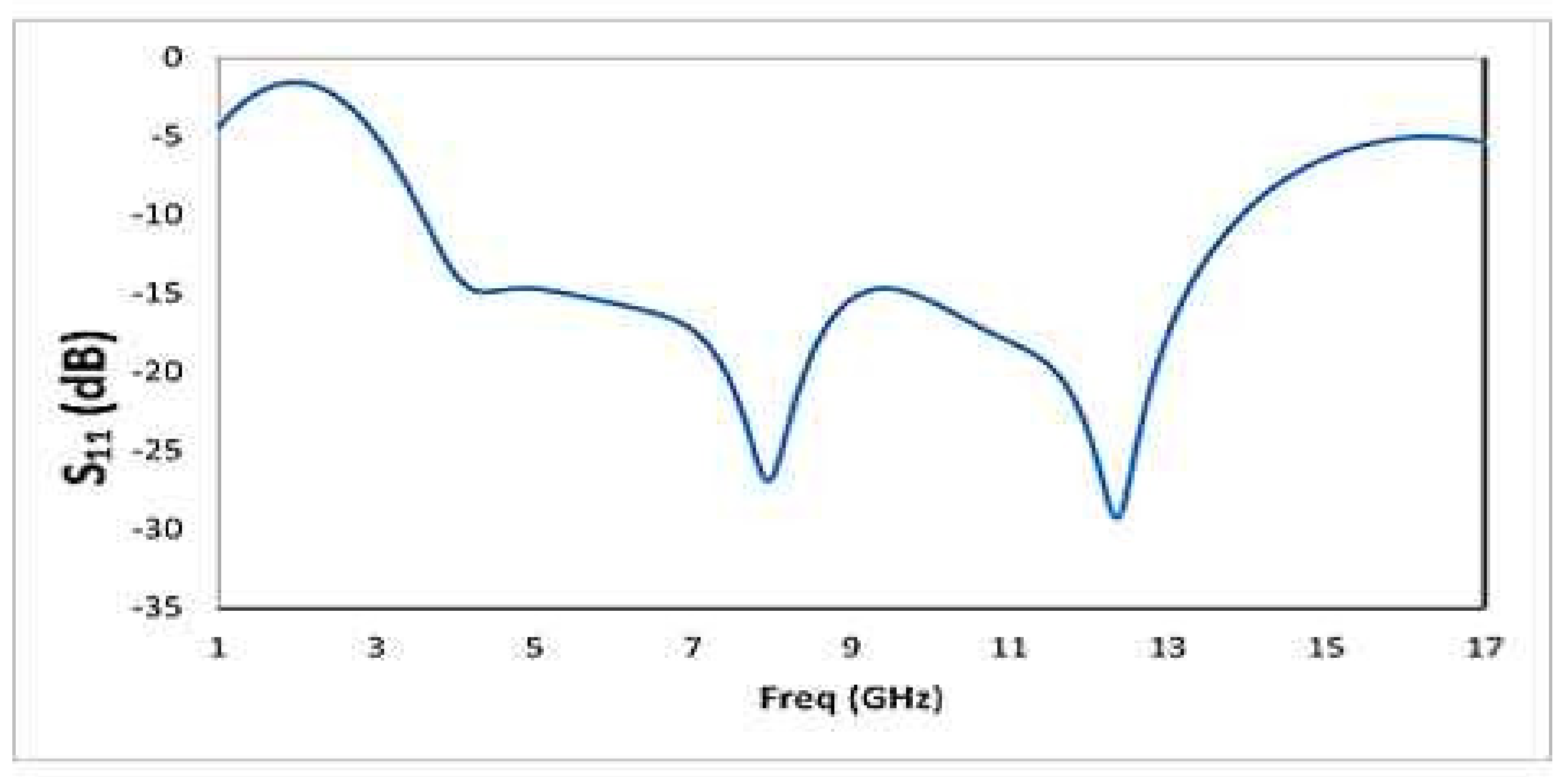
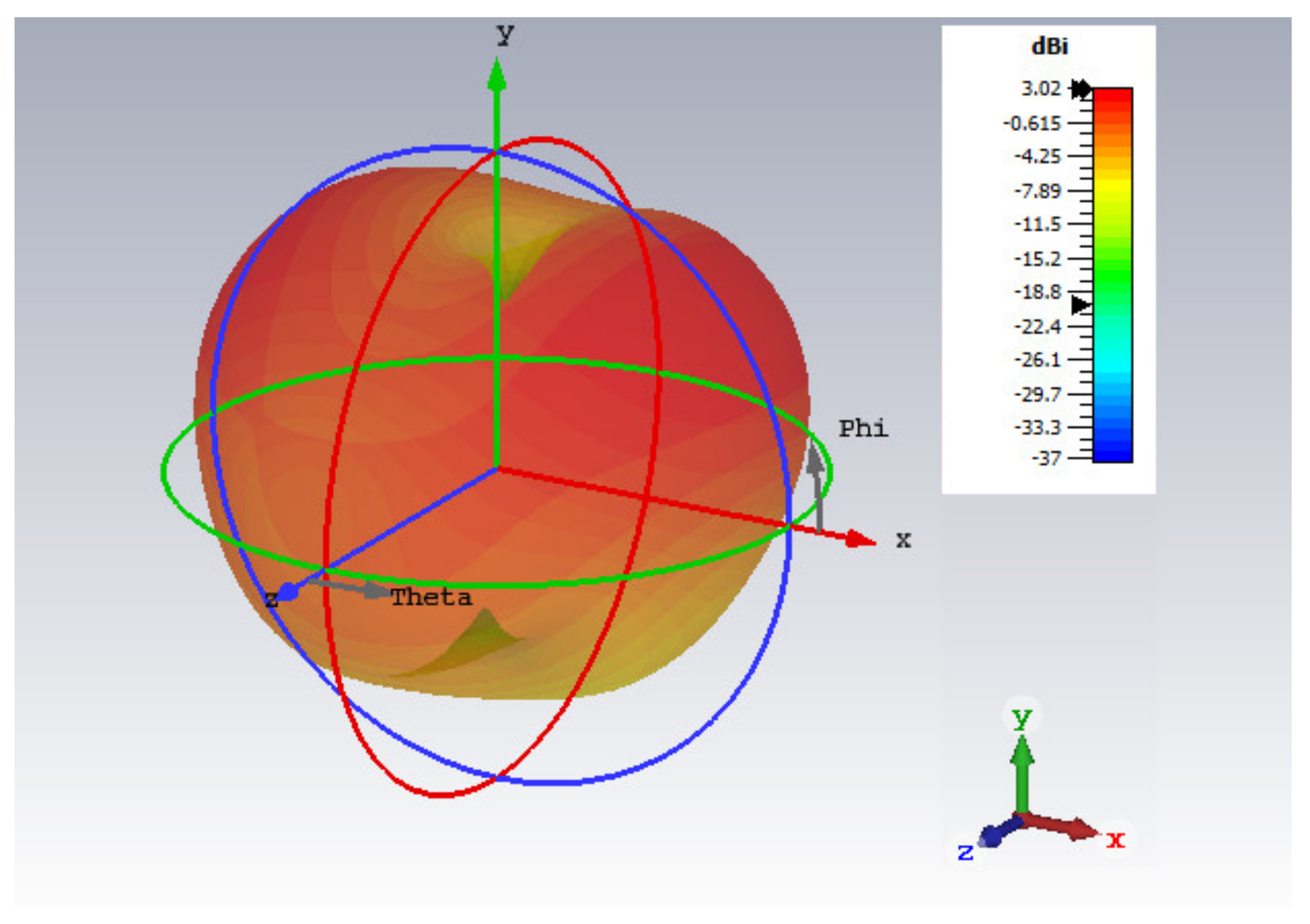
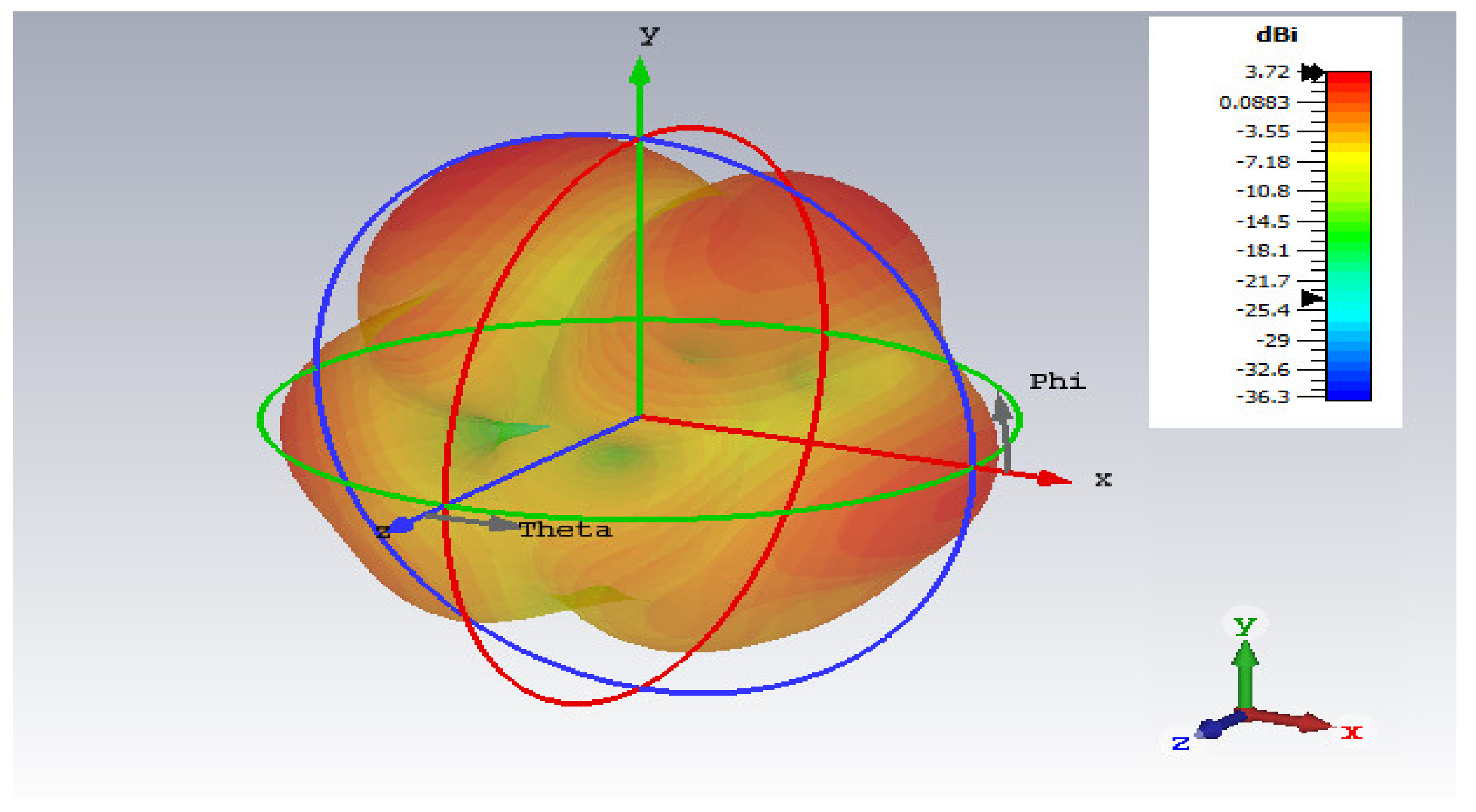

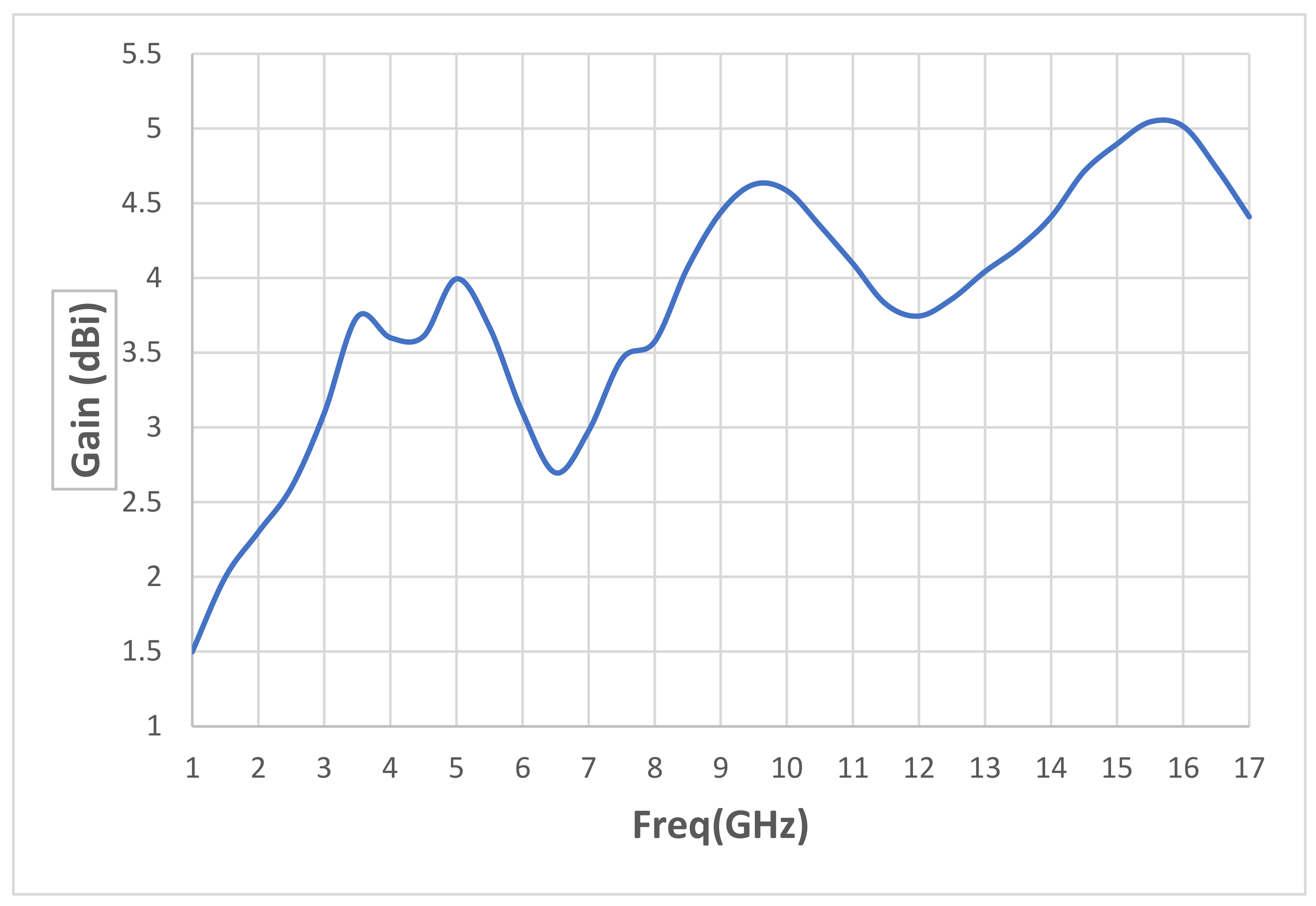
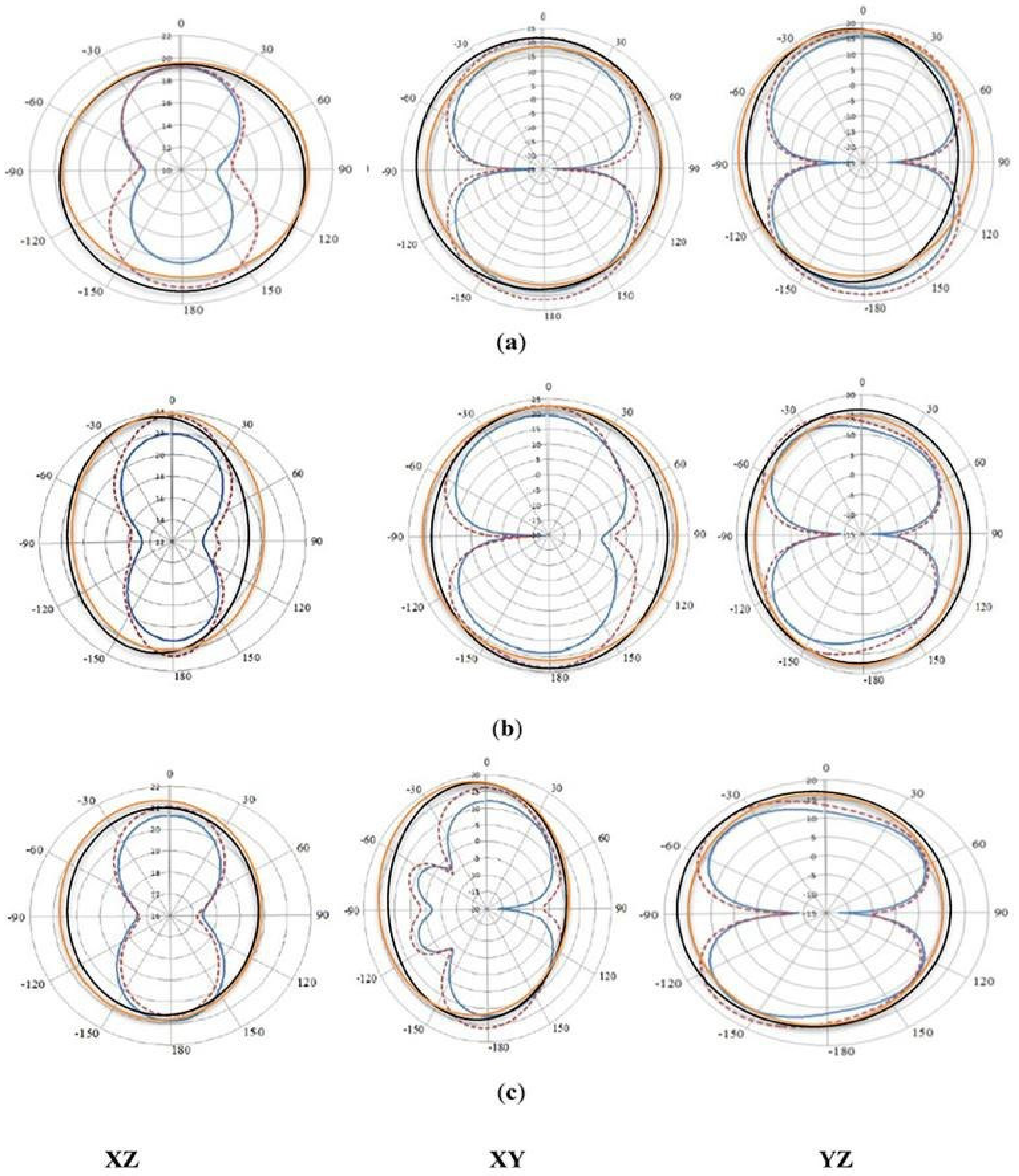
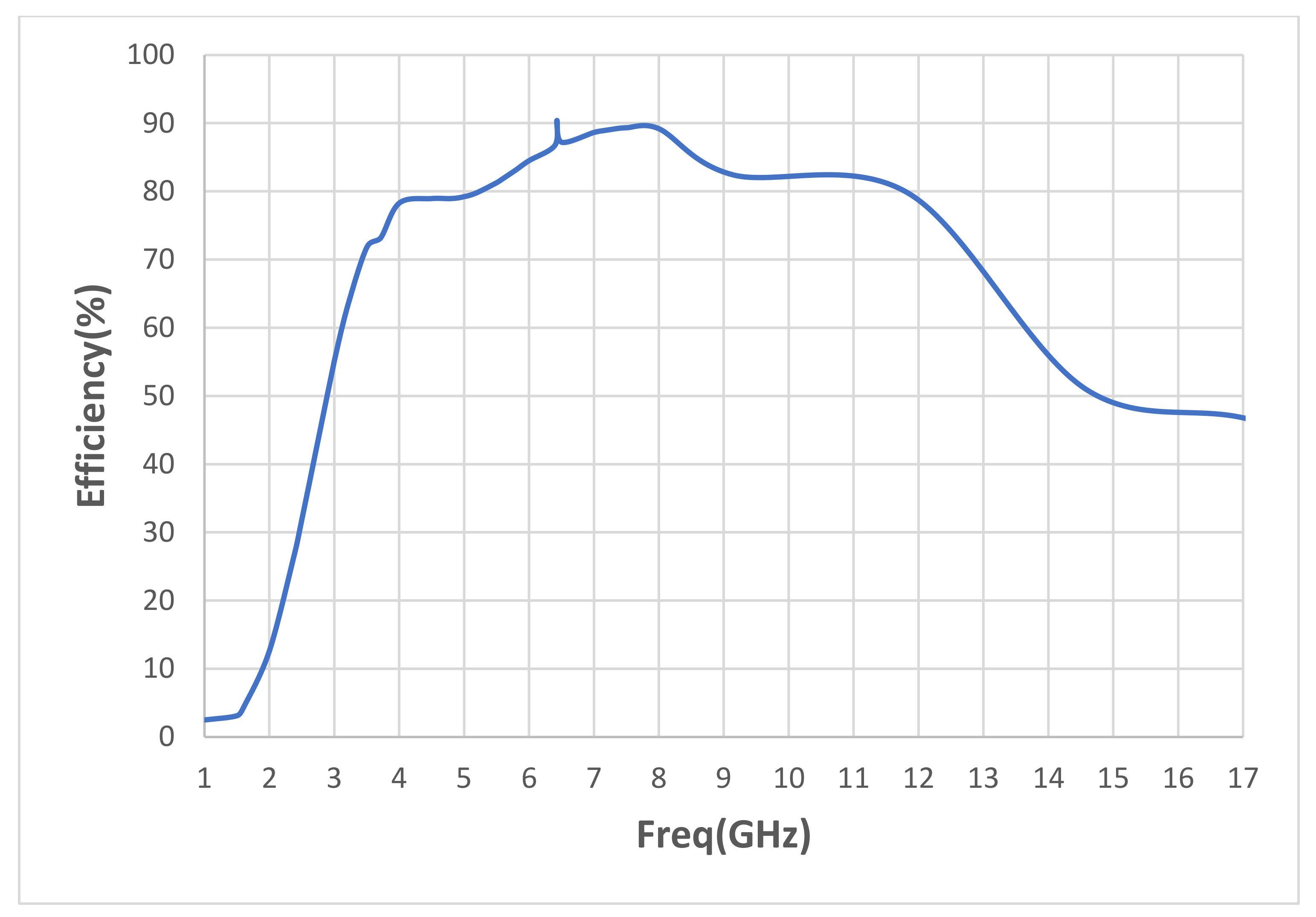
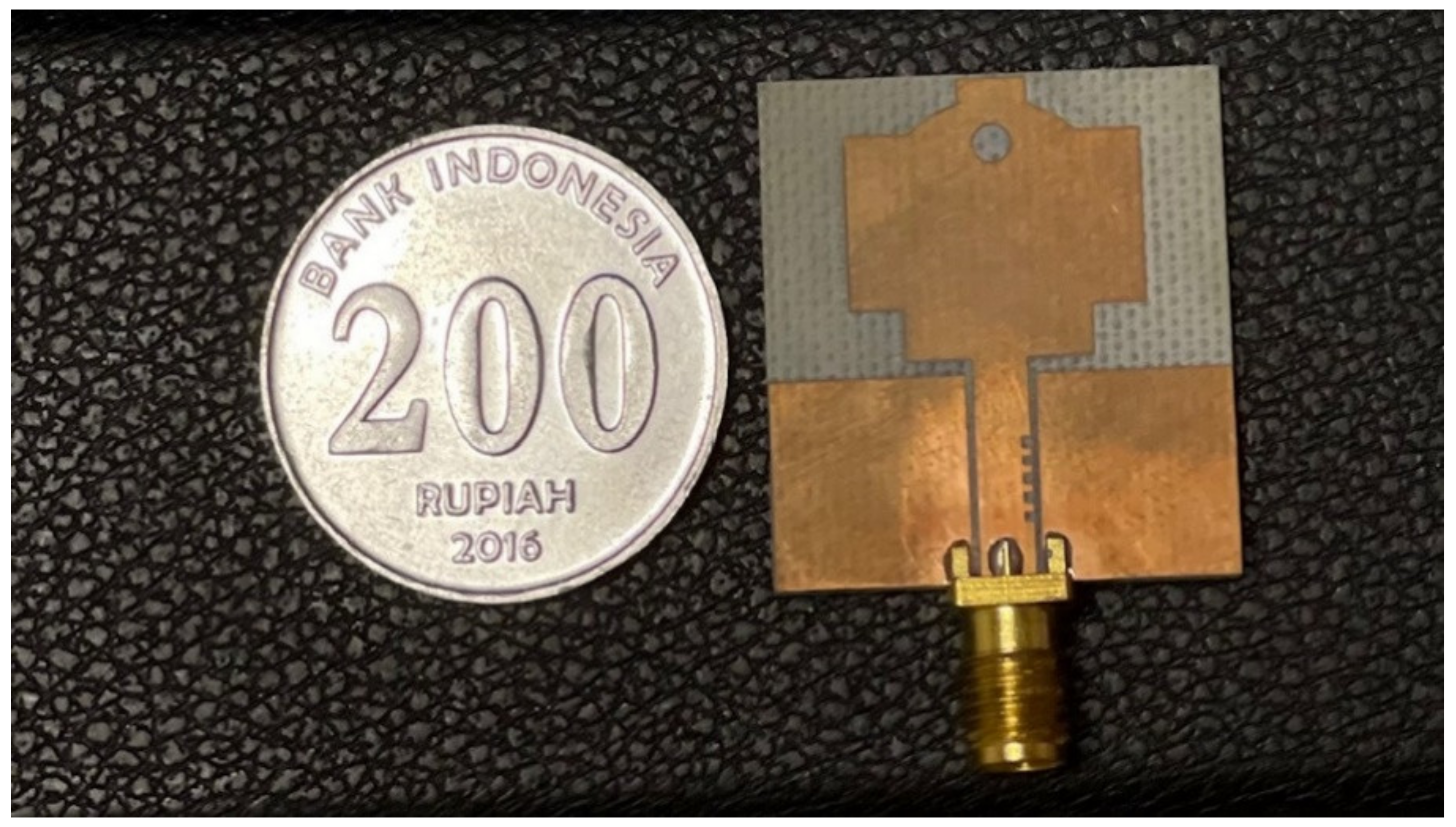
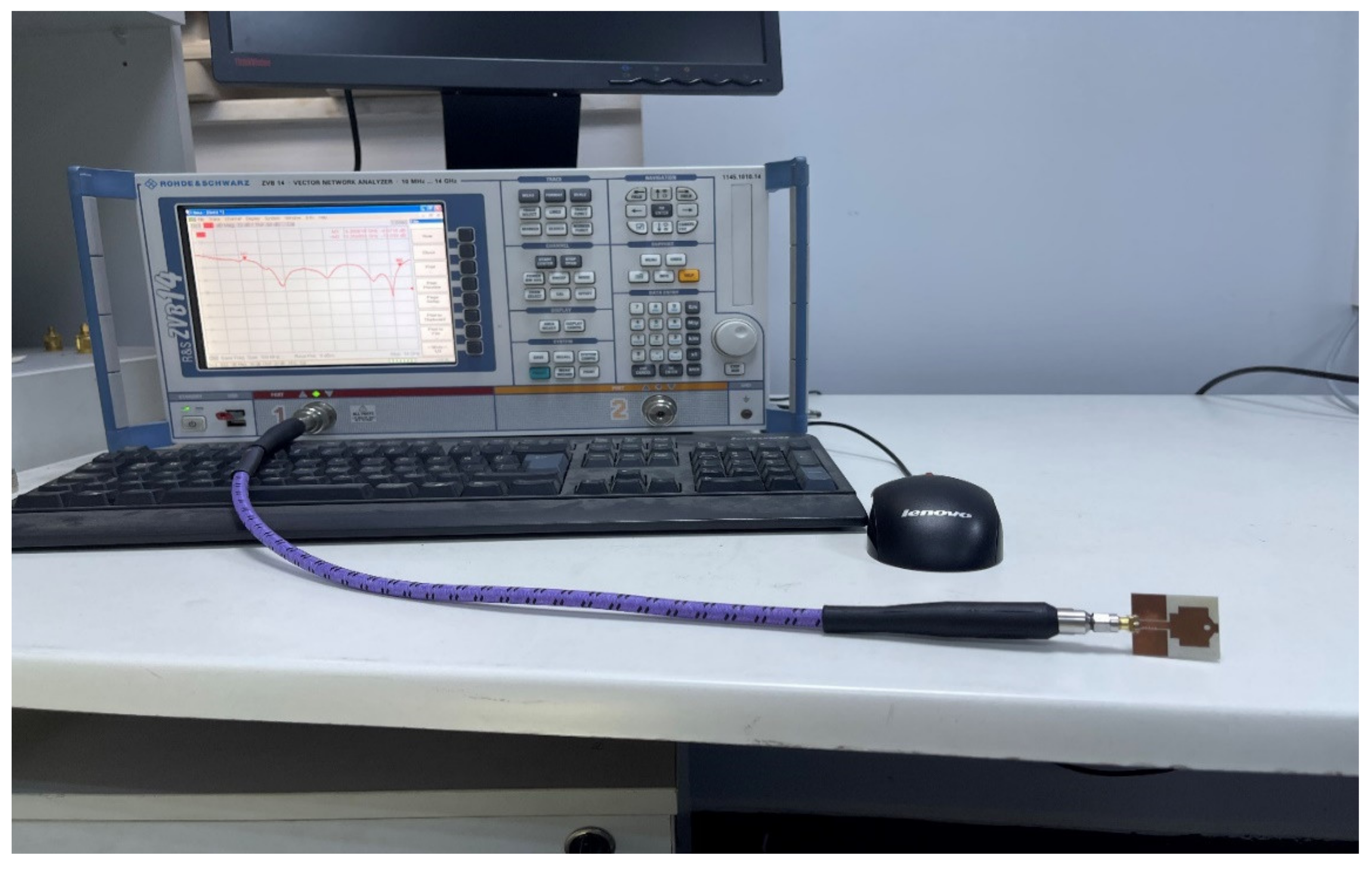

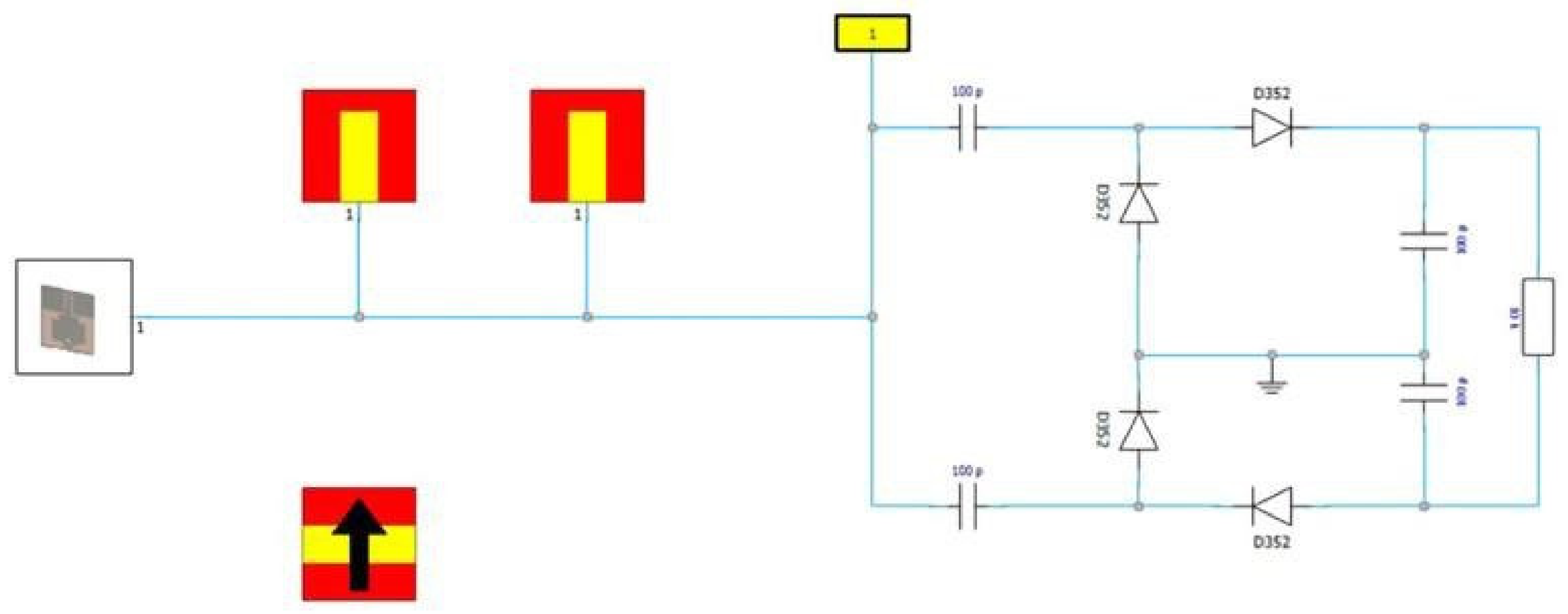


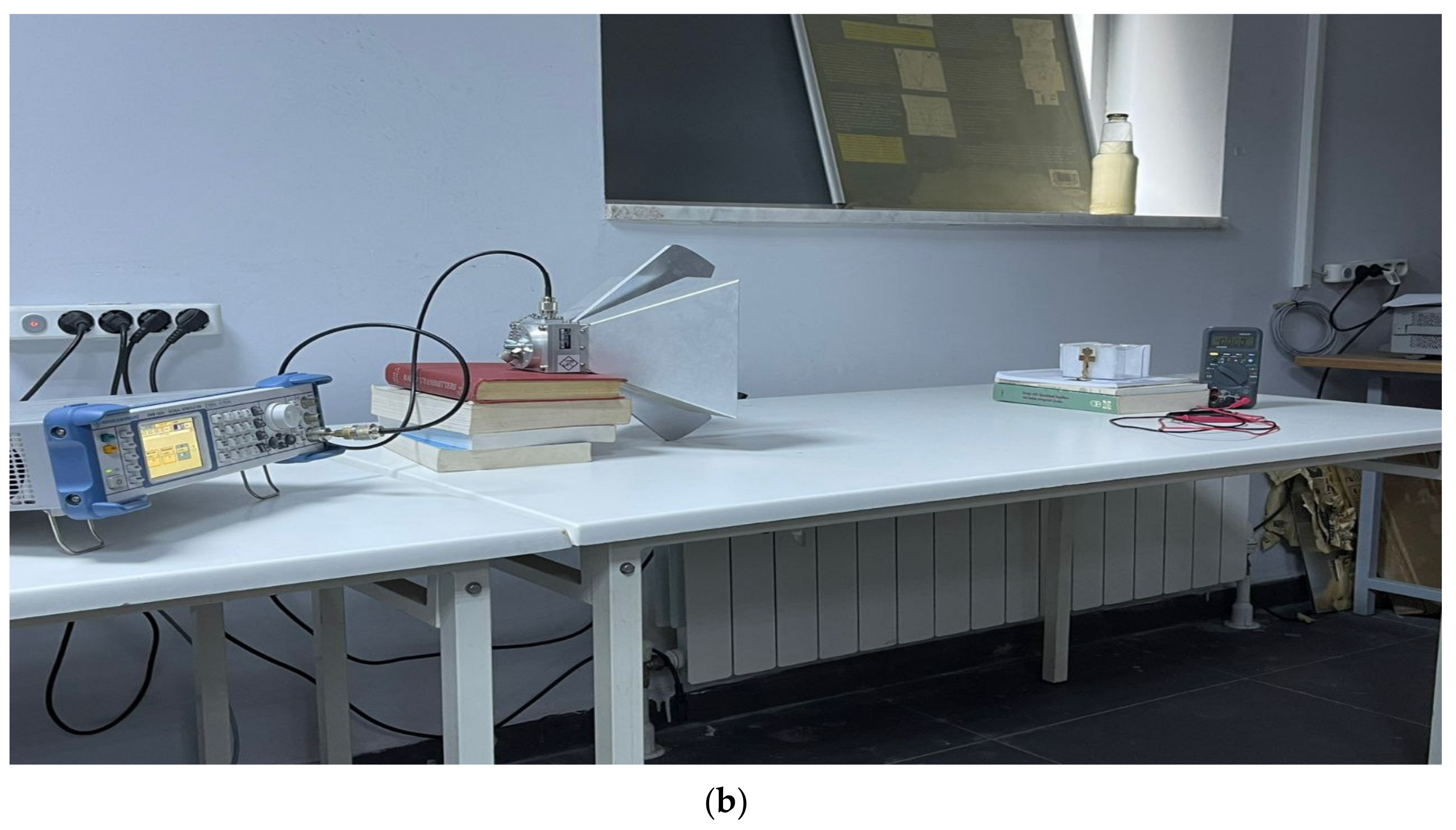
| Ref. | Max. Efficiency (%) | Max. Gain (dBi) within the Band | Dielectric Constant | Size (mm3) | Bandwidth Range (GHz) | Applications | |
|---|---|---|---|---|---|---|---|
| [26] | 83 | 3.18, 3.93 | 4.3 | 30 × 35 × 1.6 | 1.514917 | 7–9.9 | UWB applications (X-band) |
| [27] | --- | 5.5 | 4.4 | 59.5 × 30 × 1.6 | 1.832615 | 5.85–6.6 | Industrial Scientific and Medical Band applications. |
| [28] | 88 | 6.08 | 4.4 | 36 × 42 × 1.6 | 0.91854 | 4.5–13.5 | C and X band applications |
| [29] | -- | 3.5 | 4.4 | 47 × 47 × 1.6 | 0.26508 | 2–9.5 | S and C band applications |
| [30] | 40 | -- | 2.2 | 27 × 33 × 0.787 | 0.14256 | 3–11 (with 5 notches) | UWB radiofrequency identification (RFID) is used for indoor localization |
| [31] | --- | 4 | 4.4 | 44 × 27 × 0.8 | 0.3425 | 3.1–10.6 | UWB multiple-input and multiple-output (MIMO) applications |
| [32] | 27 | 4.35 | 4.4 | 80 × 67 × 0.13 | 2.201352 | 3.7–10.3 | Wearable antenna applications |
| [33] | 85 | 8 | 4.4 | 50 × 44.4 × 0.15 | 3.452544 | 7.2–9.2 | Wearable antenna applications |
| [34] | ---- | 4.8 | 2.6 | 50 × 55 × 1.6 | 0.23567 | 2.07–2.83 | Application of wideband and multiband frequency |
| [35] | 73.4 | 3.7 | 2.2 | 100 × 50 × 0.78 | 0.056889 | 0.8–3.7 | Energy harvesting |
| [36] | 58 | 3 | 2.25 | 75.5 × 63.5 × 1.6 | 3.221004 | 6.1–7.7 | Energy harvesting |
| [37] | 60 | 4.55 | 3.5 | 32 × 28 × 2.5 | 0.014336 | 0.8–10 | Low-Energy Applications |
| [38] | 44.5 | 5.4 | 4.4 | 30 × 34.5 × 1.56 | 0.77625 | 5–6 | Scalable RF Battery |
| [39] | 52 | 3 | 4.4 | 38 × 38 × 1.6 | 0.260878 | 2.454–2.45 | Wi-Fi Energy Harvesting |
| [40] | 87 | 7 | 4.4 | 50 × 40 × 1.6 | 0.0486 | 900 MHz–3 GHz 5.6 GHz–9.9 GHz | RF Energy Harvesting Applications |
| Proposed | 82 | 4.7 | 4.4 | 27 × 25 × 1.5 | 0.259677 | 3.581–13.935 | Energy harvesting |
| Transmitter Power (dBm) | Rectifier O/P Voltage (mv) |
|---|---|
| 0 | 1.17 |
| −1 | 1.14 |
| −2 | 0.84 |
| −3 | 0.50 |
| −4 | 1.59 |
| −5 | 0.89 |
| −6 | 0.81 |
| −7 | 1.19 |
| −8 | 1.65 |
| −9 | 1.48 |
| −10 | 1.1 |
Disclaimer/Publisher’s Note: The statements, opinions and data contained in all publications are solely those of the individual author(s) and contributor(s) and not of MDPI and/or the editor(s). MDPI and/or the editor(s) disclaim responsibility for any injury to people or property resulting from any ideas, methods, instructions or products referred to in the content. |
© 2023 by the authors. Licensee MDPI, Basel, Switzerland. This article is an open access article distributed under the terms and conditions of the Creative Commons Attribution (CC BY) license (https://creativecommons.org/licenses/by/4.0/).
Share and Cite
Jameel, M.S.; Mezaal, Y.S.; Atilla, D.C. Miniaturized Coplanar Waveguide-Fed UWB Antenna for Wireless Applications. Symmetry 2023, 15, 633. https://doi.org/10.3390/sym15030633
Jameel MS, Mezaal YS, Atilla DC. Miniaturized Coplanar Waveguide-Fed UWB Antenna for Wireless Applications. Symmetry. 2023; 15(3):633. https://doi.org/10.3390/sym15030633
Chicago/Turabian StyleJameel, Maryam S., Yaqeen S. Mezaal, and Dogu Cagdas Atilla. 2023. "Miniaturized Coplanar Waveguide-Fed UWB Antenna for Wireless Applications" Symmetry 15, no. 3: 633. https://doi.org/10.3390/sym15030633
APA StyleJameel, M. S., Mezaal, Y. S., & Atilla, D. C. (2023). Miniaturized Coplanar Waveguide-Fed UWB Antenna for Wireless Applications. Symmetry, 15(3), 633. https://doi.org/10.3390/sym15030633








